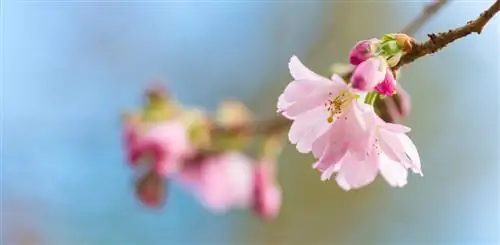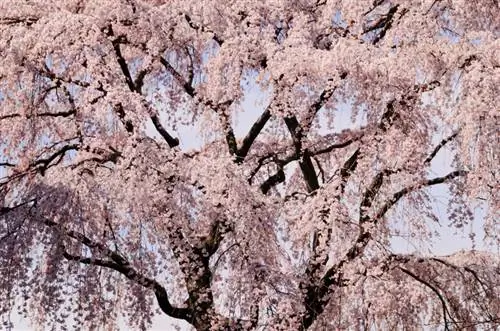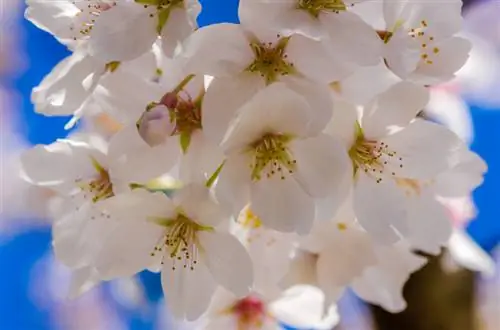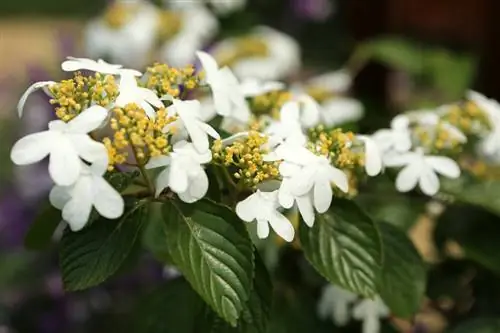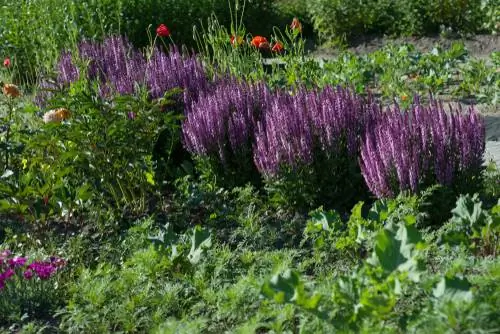- Author admin [email protected].
- Public 2023-12-25 17:45.
- Last modified 2025-01-23 11:22.
Their lavish blooms take our breath away. Where the lush pink flower clusters stretch towards the sky or lean elegantly to the ground, the Japanese cherry creates a paradisiacal flair. In order for the royal flower overture to take place in your garden, a manageable care program is required. There are no longer any open questions about the Japanese ornamental cherry.
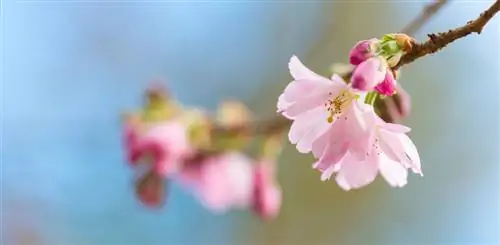
How do you care for a Japanese cherry?
The Japanese cherry impresses with its magnificent pink or white flowers in spring. Regular watering, organic fertilization in spring, a sunny location and annual pruning after flowering as well as thinning out the crown in winter are important for care.
Planting Japanese ornamental cherries correctly
The picturesque flower dream comes true when you plant the Japanese cherry in the warm autumn soil. Choose a sunny location in fresh, moist, deep soil. The roots take root more easily if the soil is prepared with as fine a crumb as possible and carefully cleaned of stones and weeds. Dig the planting pit so deep that the root ball is flush with the surface of the soil. Follow these steps:
- Enrich the excavation with horse manure (€12.00 on Amazon), bark humus or compost
- Insert the potted root ball in the middle, open any ball cloth
- Drive a support rod into the ground next to the tree without damaging the root ball
- Fill the pit with the optimized substrate, tamp down and water
A plant cut promotes lush branching. To do this, shorten the young shoots by a third. Likewise, a light root cut gives the strands the motivation to expand vitally. No more than 2-3 cm of the tips should be cut off.read more
Care tips
The main cornerstones of proper care are the water and nutrient balance as well as careful pruning. How to do it right:
- Water the Japanese cherry regularly as soon as the soil has dried to a depth of 1-2 cm
- Start the season in March/April with organic or mineral-organic fertilization
- Light pruning after flowering by shortening withered branches except for a few buds
- If necessary, extensive pruning between November and February
- Thoroughly thin out the crown every year in late winter
The Japanese flowering cherry receives winter protection in the year it is planted, as its robust winter hardiness still has to develop.
Which location is suitable?
The Japanese ornamental cherry creates its picturesque flower dress in full sun to sunny locations. There should be at least 6 hours of sunshine a day for the carnation flowers to develop in abundance. A warm and sheltered location contributes to the paradisiacal appearance in spring. Choose a spot in deep, loose, sandy-loamy soil, fresh-moist to moderately dry.
The correct planting distance
The chosen ornamental cherry variety defines the planting distance in the garden. Majestic hybrids with a height of 8-10 m and a width of 6-8 m come into their own when the distance to the neighboring bed is 5-6 m. Smaller hybrids thrive particularly over space with hanging branches, so that the expected growth width determines the planting distance. Only the columnar Japanese flowering cherry can cope with a planting distance of 80-100 cm.
When is flowering time?
The flowering period of the pure species extends from April to June. However, the magnificent hybrids do not have such staying power. The more abundant the flowers, the shorter the flowering period. For premium varieties, the spring festival sometimes lasts from the end of April to mid-May.
Cut Japanese ornamental cherries correctly
The willingness of a Japanese cherry to bloom is retained for many years if you prune the tree like this:
- From the 3rd year immediately after the flowering period, shorten all dead branches except for a few buds
- Make each cut 2-3 mm above a sleeping eye (thickening under the bark)
- In late winter, thin out the crown and cut off all dead wood on branches
- Saw thick branches from below and only then completely cut off the branch from above
Since the majority of Japanese ornamental cherry hybrids thrive in hobby gardens, wild shoots regularly sprout from the rootstock. These are immediately cut off or torn off with a jerk because they want to overgrow the noble variety.read more
Watering Japanese ornamental cherries
You incur the displeasure of the noble spring beauty when the earth gets too dry or too wet. The Japanese cherry reacts indignantly by dropping its flowers. Therefore, water moderately as soon as the surface has dried. Apply the water immediately to the root disc. After the flower festival, keep the soil constantly slightly moist.
Fertilize Japanese ornamental cherries properly
An organic starter fertilization in March/April awakens the spirit of a Japanese flowering cherry. Add compost, horn shavings, guano granules or bark humus. A regularly renewed layer of mulch made from leaves or grass clippings keeps the soil warm and moist for longer. At the same time, the organic material continuously releases valuable nutrients to the roots.
Wintering
The Japanese flowering cherry is frost-resistant down to -20 degrees Celsius. An acceptable value for the Central European climate. Adult specimens therefore do not require any special precautions before winter. During the planting year, we recommend protecting the young ornamental cherry with leaves and compost on the root disc. Additionally, place reed mats around the trunk and crown or add brushwood.
Propagate Japanese cherry trees
Since the Japanese flowering cherry is mostly a refined hybrid, only experienced gardeners dare to propagate it themselves. The magnificent tree consists of a wild rootstock that ensures he alth and a robust constitution. A delicate scion was grafted onto it, whose task is to produce a lush abundance of flowers. Cuttings therefore lack the wild rootstock unless you are familiar with oculation, copulation or grafting. If you want to try the experiment, do this:
- In the summer, cut 10-15 cm long head cuttings from non-flowering, semi-woody shoots
- Defoliate the bottom half
- Planting in small pots filled with lean substrate
After watering, place a transparent hood over each pot. In a partially shaded, protected location, the first shoots signal the successful rooting process. The cover has done its job and can be removed. Care for the cuttings until fall or next spring to plant them in a sunny location.
Is Japanese cherry poisonous?
Japanese cherry trees do not pose any he alth threats. In fact, both the cherries and the flowers and leaves are suitable for consumption. Since the taste of ornamental cherries is light years away from the aroma of real sweet cherries and morello cherries, it is ideal to leave the fruits on the tree so that the birds can enjoy them.
Beautiful varieties
- Kanzan: A magnificent variety with a lavish profusion of pink flowers on upward branches; 5-7 m high
- Kiku-Shidare-Zakura: The branches of the carnation cherry bend elegantly to the ground under the load of pink flowers; 3-5 m high
- Amanogawa: Noble Japanese flowering cherry in a slender columnar shape, dotted with carnation flowers in May and June; 3-4 m high
- Hisakura: Powerful premium variety with semi-double, carmine pink flowers on curved branches from May; 10-12 m high
- Thai Haku: White-flowering variety with a whopping 6 cm flower diameter and copper-red shoots; 6-8 m high

